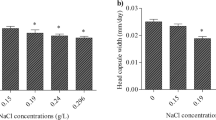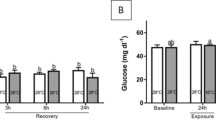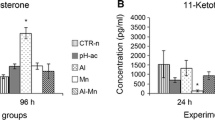Abstract
Fertilizers increase yield of crops but may have unintended negative effects on fish as a byproduct of runoff into bodies of freshwater. The objective of this study was to determine if environmentally relevant concentrations of an ammonium fertilizer impacts stress and innate immunity in Western mosquitofish (Gambusia affinis). The mosquitofish were exposed to different concentrations of ammonium sulfate fertilizer: 0 ppm, 40 ppm, and 80 ppm. To test the effects of ammonium sulfate on stress physiology, cortisol released into water by individual fish was collected after 1 week of exposure and again after 2 weeks of exposure and quantified with an enzyme immunoassay. Cortisol levels in the 0-ppm group were not significantly different over the course of the study, but we found a significant increase in cortisol levels in the fish exposed to 40 ppm and 80 ppm. We found reduced survival in fish from the 40 ppm and 80 ppm of ammonium sulfate groups compared with the 0-ppm group. We also used blood samples to complete a lysozyme assay as a measure of innate immune defense. Higher concentrations of ammonium sulfate correlated with significantly lower lysozyme activity in the fish. Overall, our results suggest that relatively low amounts of ammonium sulfate runoff into bodies of water are likely to have negative sublethal and lethal effects on small fishes.




Similar content being viewed by others
References
Aertz J, Metz JR, Ampe B, Decostere A, Filk G, Saeger SD (2015) Scales tell a story on the stress history of fish. PLoS One 10:e0123411
Alexander JB, Ingram GA (1992) Noncellular nonspecific defence mechanisms of fish. Annu Rev Fish Dis 2:249–279
Barton BA, Iwama GK (1991) Physiological changes in fish from stress in aquaculture with emphasis on the response and effects of corticosteroids. Annu Rev Fish Dis 1:3–26
Breckels RD, Neff BD (2010) Pollution-induced behavioural effects in the brown bullhead (Ameiurus nebulosus). Ecotoxicology 19:1337–1346
Brown JA (1993) Endocrine responses to environmental pollutants. In: Rankin JC, Jensen FB (eds) Fish ecophysiology. Chapman and Hall Fish and Fisheries Series, vol 9. Springer, Dordrecht
Buonocore F, Randelli E, Trisolino P, Facchiano A, de Pascale D, Scapigliati G (2014) Molecular characterization, gene structure and antibacterial activity of a g-type lysozyme from the European sea bass (Dicentrarchus labrax L.). Mol Immunol 82:10–18
Callewaert L, Michiels CW (2010) Lysozymes in the animal kingdom. J Biosci 35:127–160
Camargo JA, Alonso A (2006) Ecological and toxicological effects of inorganic nitrogen pollution in aquatic ecosystems: a global assessment. Environ Int 32:831–849
Chien SH, Gearhart M, Villagarcia S (2011) Comparison of ammonium sulfate with other nitrogen and sulfur fertilizers in increasing crop production and minimizing environmental impact: a review. Soil Sci 176:327–335
Constable M, Charlton M, Jensen F, McDonald K, Craig G, Taylor KW (2003) An ecological risk assessment of ammonia in the aquatic environment. Hum Ecol Risk Assess 9:527–548
Dunier M, Siwicki AK (1993) Effects of pesticides and other organic pollutants in the aquatic environment on immunity of fish: a review. Fish Shellfish Immunol 3:423–438
Eddy FB, Williams EM (1987) Nitrite and freshwater fish. Chem Ecol 3:1–38
Ellis AE (1990) Lysozyme assays. In: Stolen JS, Fletcher DP, Anderson BS et al (eds) Techniques in fish immunology. SOS Publications, Fair Haven, pp 101–103
Ellis T, James JD, Stewart C, Scott AP (2004) A non-invasive stress assay based upon measurement of free cortisol released into the water by rainbow trout. J Fish Biol 65:1233–1252
Fageria NK, Santos AB, Moraes MF (2010) Influence of urea and ammonium sulfate on soil acidity indices in lowland rice production. Commun Soil Sci Plant Anal 41:1565–1575
Fast MD, Hosoya S, Johnson SC, Afonso LOB (2008) Cortisol response and immune-related effects of Atlantic salmon (Salmo salar Linnaeus) subjected to short- and long-term stress. Fish Shellfish Immunol 24:194–204
Fromm PO (1980) A review of some physiological and toxicological responses of freshwater fish to acid stress. Environ Biol Fish 5:79–93
Gao FY, Qu L, Yu SG, Ye X, Tian YY, Zhang LL, Bai JJ, Lu M (2012) Identification and expression of three c-type lysozymes in Oreochromis aureus. Fish Shellfish Immunol 32:779–788
Grindley J (1946) Toxicity to rainbow trout and minnows of some substances known to be present in waste water discharge to rivers. Ann Appl Biol 33:103–112
Harper C, Wolf JC (2009) Morphologic effects of the stress response in fish. ILAR 50:387–396
Havas M, Rosseland BO (1995) Response of zooplankton, benthos, and fish to acidification: an overview. Water Air Soil Pollut 85:51–62
Hikima J, Hiorono I, Aoki T (2003) The lysozyme gene in fish. In: Shimizu N, Aoki T, Hirono I, Takashima F (eds) Aquatic Genomics. Springer, Tokyo, pp 301–309
Hontela A, Rasmussen JB, Audet C, Chevalier G (1992) Impaired cortisol stress response in fish from environments polluted by PAHs, PCBs, and mercury. Arch Environ Contam Toxicol 22:278–283
Jensen FB (2003) Nitrite disrupts multiple physiological functions in aquatic animals. Comp Biochem Physiol 135:9–24
Kültz D (2015) Physiological mechanisms used by fish to cope with salinity stress. J Exp Biol 218:1907–1914
Lewis WM, Morris DP (1986) Toxicity of nitrite to fish: a review. Trans Am Fish Soc 115:183–195
Lie Ø, Evensen Ø, Sorensen A, Froysadal E (1989) Study on lysozyme activity in some fish species. Dis Aquat Org 6:1–5
Little AG, Seebacher F (2015) Temperature determines toxicity: bisphenol A reduces thermal tolerance in fish. Environ Pollut 197:84–89
Magnadottir B (2006) Innate immunity of fish (overview). Fish Shellfish Immunol 20:137–151
Mazeaud MM, Mazeaud F, Donaldson EM (1977) Primary and secondary effects of stress in fish: some new data and a general review. Trans Am Fish Soc 106:201–212
Mock A, Peters G (1990) Lysozyme activity in rainbow trout, Oncorhynchus mykiss (Walbaum), stressed by handling, transport and water pollution. J Fish Biol 37:873–885
Mulla MS (1966) Toxicity of new organic insecticides to mosquito fish and some other aquatic organisms. Mosquito News 1:87–91
Pascual P, Pedrajas JR, Toribio F, Lopez-Barea J, Peinado J (2003) Effects of food deprivation on oxidative stress biomarkers in fish (Sparus aurata). Chemico-Biol Interact 145:191–199
Philips S, Laanbroek HJ, Verstraete W (2002) Origin, causes and effects of increased nitrite concentrations in aquatic environments. Rev Environ Sci Biotechnol 1:115–141
Pickering AD, Pottinger TD, Christie PJ (1982) Recovery of the brown trout Salmo trutta from acute handling stress: a time course study. J Fish Biol 20:229–244
Pickering AD, Pottinger TD, Sumpter JP, Carragher JF, Le Bail PY (1991) Effects of acute and chronic stress on the levels of circulating growth hormone in the rainbow trout Oncorynchus mykiss. Gen Comp Endocrinol 83:86–93
Pyke GG (2008) Plague minnow or mosquito fish? A review of the biology and impacts of introduced Gambusia species. Annu Rev Ecol Evol Syst 39:171–191
Rakers S, Gebert M, Uppalapati S, Meyer W, Maderson P, Sell AF, Kruse C, Paus R (2011) ‘Fish matters’: the relevance of fish skin biology to investigate dermatology. Exp Dermatol 10:1600–1625
Ram RN, Sathyanesan AG (1986) Inclusion bodies: formation and degeneration of the oocytes in the fish Channa punctatus (Bloch) in response to ammonium sulfate treatment. Ecotoxicol Environ Saf 11:272–276
Ram RN, Sathyanesan AG (1987) Histopathological changes in liver and thyroid of the teleost fish, Channa punctatus (Bloch), in response to ammonium sulfate fertilizer treatment. Ecotoxicol Environ Saf 13:185–190
Ram RN, Singh SK (1988) Long-term effect of ammonium sulfate fertilizer on histophysiology of adrenal in the teleost, Channa punctatus (Bloch). Bull Environ Contam Toxicol 41:880–887
Richardson J (1997) Acute ammonia toxicity for eight New Zealand indigenous freshwater species. N Z J Mar Freshw Res 31:185–190
Roche H, Boge G (1996) Fish blood parameters as a potential tool for identification of stress caused by environmental factors and chemical intoxication. Mar Envioron Res 41:27–43
Russo RC (1985) Ammonia, nitrite and nitrate. In: Rand GM, Petrocelli SR (eds) Fundamentals of aquatic toxicology. Hemisphere Publishing Corporation, Washington, pp 455–471
Ryan JA, Hightower LE (1994) Evaluation of heavy-metal ion toxicity in fish cells using a combined stress protein and cytotoxicity assay. Environ Toxicol Chem 13:1231–1240
Saurabh S, Sahoo PK (2008) Lysozyme: an important defense molecule of fish innate immune system. Aquac Res 39:223–239
Savci S (2012) An agricultural pollutant: chemical fertilizer. International Journal of Environmental Science and Development. https://doi.org/10.7763/IJESD.2012.V3.191
Schram E, Roques JAC, Abbink W, Spanings T, de Vries P, Bierman S, van de Vis H, Flik G (2010) The impact of elevated water ammonia concentration on physiology, growth and feed intake of African catfish (Clarias gareipinus). Aquaculture 306:108–115
Schreck CB (2009) Stress and fish reproduction: The roles of allostasis and hormesis. Gen Comp Endocrinol 165:549–556
Schulte PM (2014) What is environmental stress? Insights from fish living in a variable environment. J Exp Biol 217:23–34
Segner H (1987) Response of fed and starved roach, Rutilus rutilus, to sublethal copper contamination. J Fish Biol 30:423–437
Small BC, Bilodeau AL (2005) Effects of cortisol and stress on channel catfish (Ictalurus punctatus) pathogen susceptibility and lysozyme activity following exposure to Edwardsiella ictaluri. Gen Comp Endocrinol 142:256–262
Subramanian S, MacKinnon SL, Ross NW (2007) A comparative study on innate immune parameters in the epidermal mucus of various fish species. Comp Biochem Physiol B 148:256–263
Surace M, Geoffery S (2016) Female body size and reproduction in western mosquitofish (Gambusia affinis) from two ponds in central Ohio. Northeast Nat 23:1–10
Swenton DM, Kodric-Brown A (2012) Habitat and life history differences between two species of Gambusia. Environ Biol Fish 94:669–680
Takahara T, Yamanaka H, Suzuki AA, Honjo MN, Minamoto T, Yonekura R, Itayama T, Kohmatsu Y, Ito T, Kawabata Z (2011) Stress response to daily temperature fluctuations in common carp, Cyprinus carpio L. Hydrobiologia 675:65–73
Tomasso JR, Davis KB, Simco BA (1981) Plasma corticosteroid dynamics in channel catfish (Ictalurus punctatus) exposed to ammonia and nitrite. Can J Fish Aquat Sci 38:1106–1112
Tort L (2011) Stress and immune modulation in fish. Dev Comp Immunol 35:1366–1375
Vijayan MM, Ballantyne JS, Leatherland JF (1991) Cortisol induced changes in some aspects of intermediary metabolism of Salvelinus fontinalis. Gen Comp Endcrinol 82:476–486
Wallen IE, Greer WC, Lasater R (1957) Toxicity to “Gambusia affinis” of certain pure chemicals in turbid waters. Sewage Indust Waste 29:695–711
Wendelaar Bonga SE (1997) The stress response in fish. Physiol Rev 77:591–625
Funding
This study was funded by an Undergraduate Student Research Grant from the Illinois State Academy of Science to E. Schnabel and by the Millikin University Biology Department.
Author information
Authors and Affiliations
Corresponding author
Ethics declarations
All methods were approved by the Millikin University Institutional Animal Care and Use Committee (Protocol 17-012).
Conflict of interest
The authors declare that they have no conflict of interest.
Additional information
Publisher’s note
Springer Nature remains neutral with regard to jurisdictional claims in published maps and institutional affiliations.
Rights and permissions
About this article
Cite this article
Schnabel, E., Wilcoxen, T.E. Effects of ammonium sulfate on stress physiology and innate immunity of Western mosquitofish (Gambusia affinis). Fish Physiol Biochem 46, 2027–2035 (2020). https://doi.org/10.1007/s10695-020-00855-z
Received:
Accepted:
Published:
Issue Date:
DOI: https://doi.org/10.1007/s10695-020-00855-z




